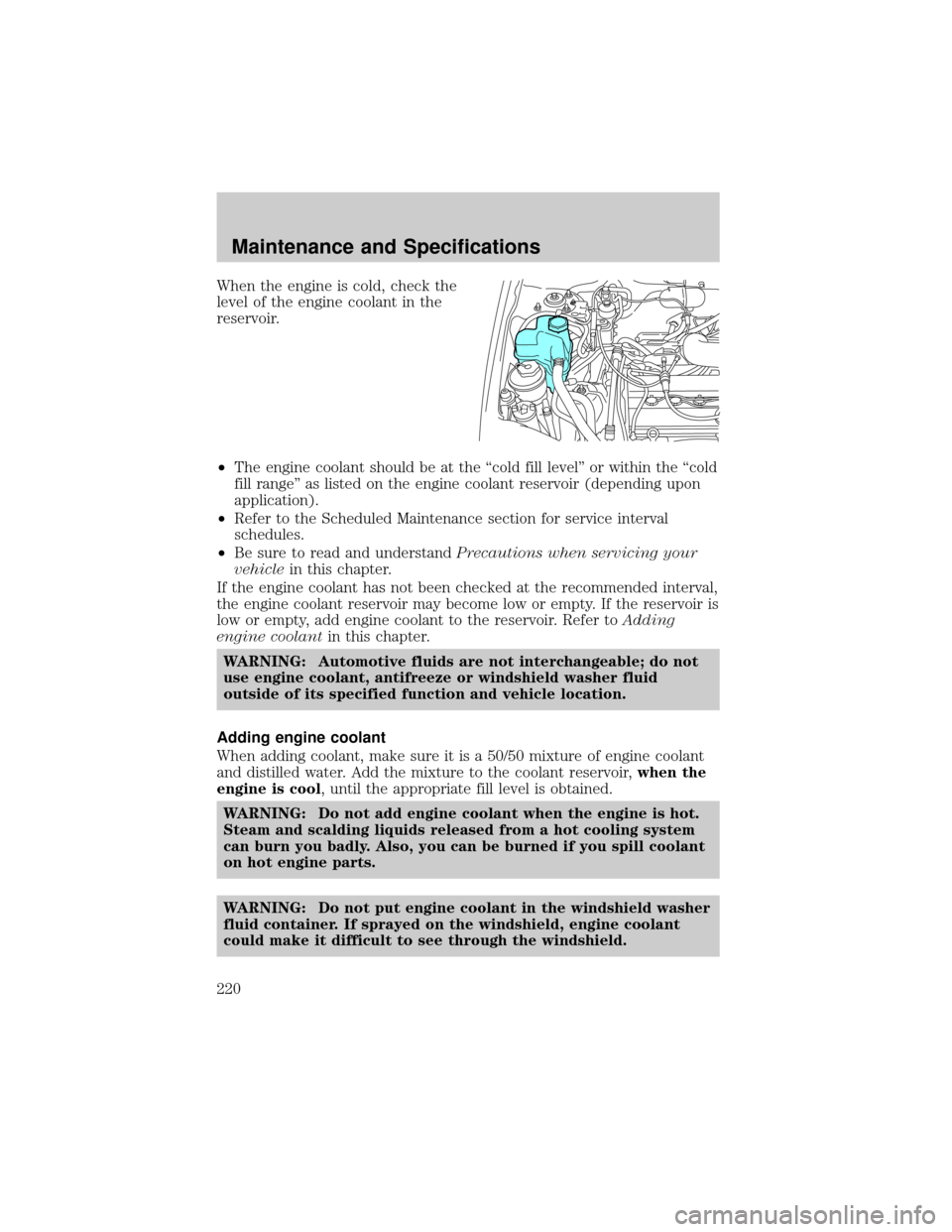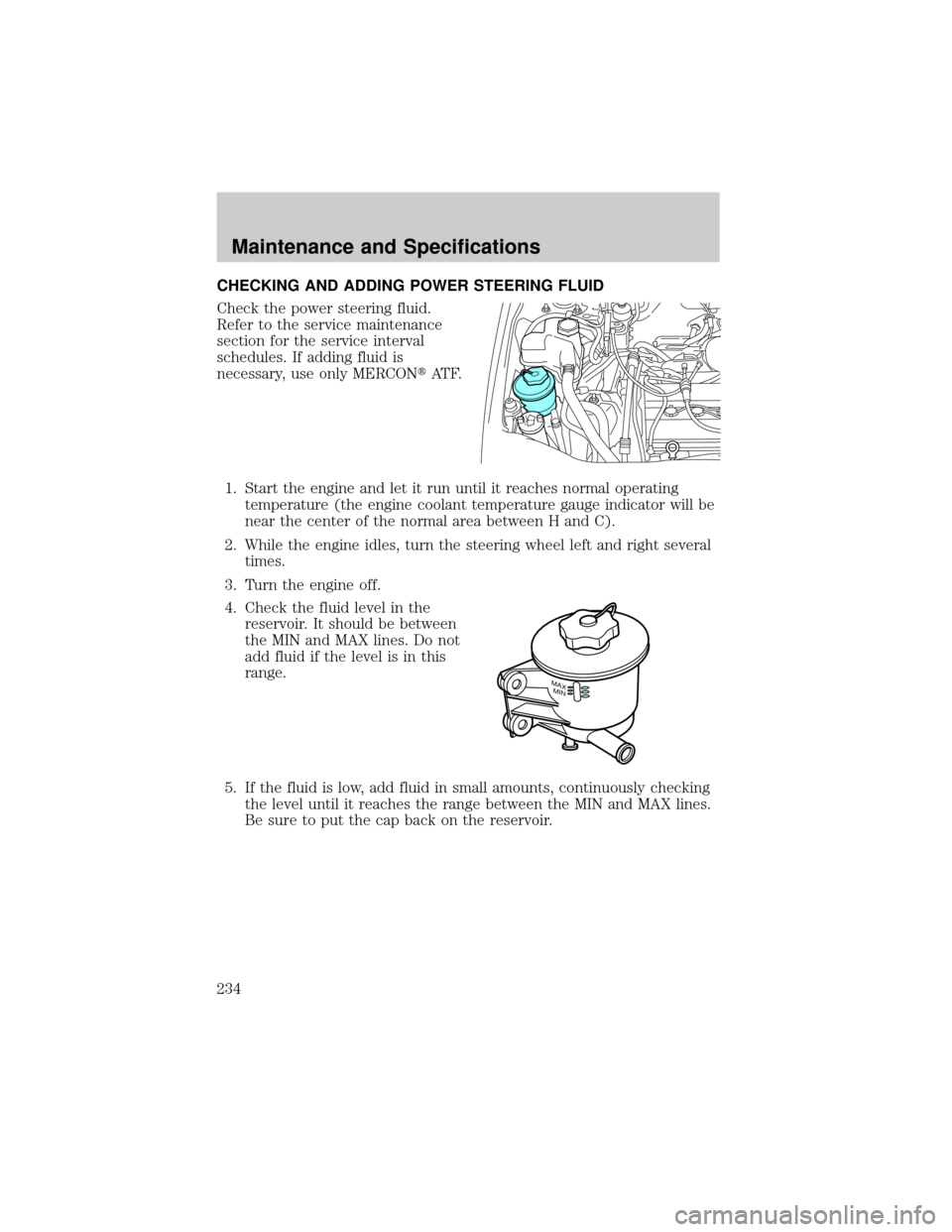engine coolant MAZDA MODEL TRIBUTE 2002 (in English) User Guide
[x] Cancel search | Manufacturer: MAZDA, Model Year: 2002, Model line: MODEL TRIBUTE, Model: MAZDA MODEL TRIBUTE 2002Pages: 256, PDF Size: 2.66 MB
Page 220 of 256

When the engine is cold, check the
level of the engine coolant in the
reservoir.
²The engine coolant should be at the ªcold fill levelº or within the ªcold
fill rangeº as listed on the engine coolant reservoir (depending upon
application).
²Refer to the Scheduled Maintenance section for service interval
schedules.
²Be sure to read and understandPrecautions when servicing your
vehiclein this chapter.
If the engine coolant has not been checked at the recommended interval,
the engine coolant reservoir may become low or empty. If the reservoir is
low or empty, add engine coolant to the reservoir. Refer toAdding
engine coolantin this chapter.
WARNING: Automotive fluids are not interchangeable; do not
use engine coolant, antifreeze or windshield washer fluid
outside of its specified function and vehicle location.
Adding engine coolant
When adding coolant, make sure it is a 50/50 mixture of engine coolant
and distilled water. Add the mixture to the coolant reservoir,when the
engine is cool, until the appropriate fill level is obtained.
WARNING: Do not add engine coolant when the engine is hot.
Steam and scalding liquids released from a hot cooling system
can burn you badly. Also, you can be burned if you spill coolant
on hot engine parts.
WARNING: Do not put engine coolant in the windshield washer
fluid container. If sprayed on the windshield, engine coolant
could make it difficult to see through the windshield.
Maintenance and Specifications
220
Page 221 of 256

The cooling system in your vehicle is filled with either green-colored or
yellow-colored Mazda Premium Engine Coolant meeting Mazda
Specifications. To determine your vehicle's coolant type (color), check
your coolant reservoir.
To maintain the integrity of the coolant and the cooling system
and maintain the warranty on the cooling system:
²Add Mazda Premium Engine Coolant or the type of coolant
originally equipped in your vehicle.If you are unsure which type
of coolant your vehicle requires, check your coolant reservoir or
contact your local dealer.
²Do not add/mix an orange-colored, extended life coolant such
as Mazda Speciality Orange Engine Coolant, meeting Mazda
specifications with the factory-filled coolant.Mixing Mazda
Speciality Orange Engine Coolant or any orange-colored extended life
product with your factory filled coolant can result in degraded
corrosion protection.
²A large amount of water without engine coolant may be added, in case
of emergency, to reach a vehicle service location. In this instance, the
cooling system must be drained and refilled with a 50/50 mixture of
engine coolant and distilled water as soon as possible. Water alone
(without engine coolant) can cause engine damage from corrosion,
overheating or freezing.
²Do not use alcohol, methanol or brine or any engine coolants
mixed with alcohol or methanol antifreeze (coolant).Alcohol
and other liquids can cause engine damage from overheating or
freezing.
²Do not add extra inhibitors or additives to the coolant.These
can be harmful and compromise the corrosion protection of the engine
coolant.
²Do not mix with recycled coolant unless from a
Mazda-approved recycling process (seeUse of Recycled Engine
Coolantsection.
For vehicles with overflow coolant systems with a non-pressurized cap
on the coolant recovery system, add coolant to the coolant recovery
reservoir when the engine is cool. Add the proper mixture of coolant and
water to the ªcold fullº level. For all other vehicles, which have a coolant
degas system with a pressurized cap, or if it is necessary to remove the
coolant pressure relief cap on the radiator of a vehicle with an overflow
system, follow these steps to add engine coolant.
Maintenance and Specifications
221
Page 222 of 256

WARNING: To reduce the risk of personal injury, make sure the
engine is cool before unscrewing the coolant pressure relief
cap. The cooling system is under pressure; steam and hot liquid
can come out forcefully when the cap is loosened slightly.
1. Before you begin, turn the engine off and let it cool.
2. When the engine is cool, wrap a thick cloth around the coolant
pressure relief cap on the coolant reservoir (an opaque plastic
bottle). Slowly turn cap counterclockwise (left) until pressure begins
to release.
3. Step back while the pressure releases.
4. When you are sure that all the pressure has been released, use the
cloth to turn it counterclockwise and remove the cap.
5. Fill the coolant reservoir slowly with the proper coolant mixture (see
above), to within the ªcold fill rangeº or the ªcold fullº level on the
reservoir. If you removed the radiator cap in an overflow system, fill
the radiator until the coolant is visible and radiator is almost full.
6. Replace the cap. Turn until tightly installed. (Cap must be tightly
installed to prevent coolant loss.)
After any coolant has been added, run the engine for a few minutes to
mix the coolant. Check the coolant concentration. Make sure the engine
is off and cool before removing the coolant pressure relief cap (see
preceding steps on cap removal). Check the concentration per the
Checking Engine Coolantsection. If the concentration is not 50/50
(protection to ±34ÉF/±36ÉC), drain some coolant and adjust the
concentration. It may take several drains and additions to obtain a 50/50
coolant concentration.
Whenever coolant has been added, the coolant level in the coolant
reservoir should be checked the next few times you drive the vehicle. If
necessary, add enough 50/50 concentration of engine coolant and
distilled water to bring the liquid level to the proper level.
If you have to add more than 1.0 liter (1.0 quart) of engine coolant per
month, have your dealer check the engine cooling system. Your cooling
system may have a leak. Operating an engine with a low level of coolant
can result in engine overheating and possible engine damage).
Maintenance and Specifications
222
Page 223 of 256

Recycled engine coolant
Not all coolant recycling processes produce coolant which meets
Mazda recommend coolants. Use of a recycled engine coolant
which does not meet the Mazda recommended coolant, may harm
engine and cooling system components.
Always dispose of used automotive fluids in a responsible manner.
Follow your community's regulations and standards for recycling and
disposing of automotive fluids.
Coolant refill capacity
To find out how much fluid your vehicle's cooling system can hold, refer
toRefill capacitiesin this chapter.
Fill your engine coolant reservoir as outlined inAdding engine coolant
in this chapter.
Severe climates
If you drive in extremely cold climates (less than ±36É C [±34É F]):
²It may be necessary to increase the coolant concentration
above 50%.
²NEVER increase the coolant concentration above 60%.
²Increased engine coolant concentrations above 60% will
decrease the overheat protection characteristics of the engine
coolant and may cause engine damage.
²Refer to the chart on the coolant container to ensure the
coolant concentration in your vehicle will provide adequate
freeze protection at the temperatures in which you drive in the
winter months.
If you drive in extremely hot climates:
²It is still necessary to maintain the coolant concentration
above 40%.
²NEVER decrease the coolant concentration below 40%.
²Decreased engine coolant concentrations below 40% will
decrease the corrosion protection characteristics of the engine
coolant and may cause engine damage.
²Decreased engine coolant concentrations below 40% will
decrease the freeze protection characteristics of the engine
coolant and may cause engine damage.
Maintenance and Specifications
223
Page 224 of 256

²Refer to the chart on the coolant container to ensure the
coolant concentration in your vehicle will provide adequate
protection at the temperatures in which you drive.
Vehicles driven year-round in non-extreme climates should use a 50/50
mixture of engine coolant and distilled water for optimum cooling system
and engine protection.
WHAT YOU SHOULD KNOW ABOUT AUTOMOTIVE FUELS
Important safety precautions
WARNING: Do not overfill the fuel tank. The pressure in an
overfilled tank may cause leakage and lead to fuel spray and
fire.
WARNING: The fuel system may be under pressure. If the fuel
filler cap is venting vapor or if you hear a hissing sound, wait
until it stops before completely removing the fuel filler cap.
Otherwise, fuel may spray out and injure you or others.
WARNING: If you do not use the proper fuel filler cap,
excessive pressure or vacuum in the fuel tank may damage the
fuel system or cause the fuel cap to disengage in a collision,
which may result in possible personal injury.
WARNING: Automotive fuels can cause serious injury or death
if misused or mishandled.
WARNING: Gasoline may contain benzene, which is a
cancer-causing agent.
Observe the following guidelines when handling automotive fuel:
Maintenance and Specifications
224
Page 234 of 256

CHECKING AND ADDING POWER STEERING FLUID
Check the power steering fluid.
Refer to the service maintenance
section for the service interval
schedules. If adding fluid is
necessary, use only MERCONtAT F.
1. Start the engine and let it run until it reaches normal operating
temperature (the engine coolant temperature gauge indicator will be
near the center of the normal area between H and C).
2. While the engine idles, turn the steering wheel left and right several
times.
3. Turn the engine off.
4. Check the fluid level in the
reservoir. It should be between
the MIN and MAX lines. Do not
add fluid if the level is in this
range.
5. If the fluid is low, add fluid in small amounts, continuously checking
the level until it reaches the range between the MIN and MAX lines.
Be sure to put the cap back on the reservoir.
MAXMIN
Maintenance and Specifications
234
Page 245 of 256

Fluid Classification Application Capacity
Transmission
fluid
1API service GL-4
or GL-5, SAE
75W-90Manual transaxle
(2WD)2.7L (2.85
quarts)2
Manual transaxle
(4X4)2.2L (2.32
quarts)2
MERCONtATF 3.0L engine with
Automatic
transaxle and oil
cooler12.7L (13.4
quarts)3
Transfer Case SAE 75W-140
Synthetic
Lubricant4X4 (Automatic) 0.35L (12
ounces)
API service
GL-5, SAE
80W-904X4 (Manual) 0.35L (12
ounces)
Engine coolant
4Mazda
green-colored or
yellow-colored
Premium Engine
Coolant2.0L I4 Zetec
engine with
manual
transaxle5.0L (5.3
quarts)
3.0L V6 Duratec
engine with
automatic
transaxle10.0L (10.6
quarts)
Rear axle
lubricantSAE 80W-90
Premium Rear
Axle Lubricant4X4 1.4L (2.96 pints)
5
Windshield
washer fluidn/a All 2.6L (2.7
quarts)
1Ensure the correct automatic transmission fluid is used. Transmission
fluid requirements are indicated on the dipstick or on the dipstick
handle. MERCONtand MERCONtV are not interchangeable. DO NOT
mix MERCONtand MERCONtV. Refer to your scheduled maintenance
section to determine the correct service interval.
2Service refill capacity is determined by filling the transmission to the
bottom of the filler hole with the vehicle on a level surface.
Maintenance and Specifications
245
Page 246 of 256

3Indicates only approximate dry-fill capacity. Some applications may vary
based on cooler size and if equipped with an in-tank cooler. The amount
of transmission fluid and fluid level should be set by the indication on
the dipstick's normal operating range.
4Add the coolant type originally equipped in your vehicle. DO NOT USE
Extended Life Engine Coolant (orange in color). Refer toAdding engine
coolantin this chapter.
5Fill to 6 mm to 14 mm (1/4 inch to 9/16 inch) below bottom of fill hole.
For further information on your lubrication specifications, see your
authorized Mazda dealer.
WHEEL AND TIRE SIZES
Vehicle
GradeWheel Tire Spare
WheelSpare Tire
DX/DX-V6 6.5JJx16 215/70R16 17x4T 135/90R17
LX-V6/ES-V6 7.0JJx16 235/70R16 17x4T 145/90R17
ENGINE SPECIFICATIONS
Engine 2.0L DOHC I4 Zetec
engine3.0L DOHC V6
Duratec engine
Cubic inches 121 181
Required fuel 87 octane 87 octane
Firing order 1-3-4-2 1-4-2-5-3-6
Spark plug gap 1.22-1.32 mm
(0.048-0.052 inch)1.32-1.42 mm
(0.052-00.056 inch)
Ignition system DIS Coil on plug
Compression ratio 9.6:1 10.0:1
Maintenance and Specifications
246
Page 251 of 256

A
ABS (see Brakes) .....................135
Air bag supplemental restraint
system ................................109, 114
and child safety seats ............111
description ......................109, 114
disposal ............................113, 117
driver air bag ..................111, 116
indicator light ...........12, 113, 117
operation .........................111, 116
passenger air bag ...........111, 116
side air bag ..............................114
Air cleaner filter ...............238±239
Air conditioning
manual heating and air
conditioning system .................50
All Wheel Drive (AWD),
driving off road .........................148
Antifreeze (see Engine
coolant) .....................................219
Anti-lock brake system
(see Brakes) ......................135±136
Anti-theft system ........................85
arming the system ....................85
disarming a triggered system ..86
warning light .............................13
Audio system (see Radio) ...19, 31
Automatic transaxle .................139
driving with .............................141
fluid, adding ............................236
fluid, checking ........................236
Automatic transmission
fluid, refill capacities ..............244
Auxiliary power point .................66
Axle
refill capacities ........................244
B
Battery .......................................217acid, treating emergencies .....217
charging system warning
light ............................................13
jumping a disabled battery ....180
maintenance-free ....................217
servicing ..................................217
Brakes ........................................134
anti-lock ...........................135±136
anti-lock brake system (ABS)
warning light .....................13, 136
brake warning light ..................12
fluid, checking and adding ....235
fluid, refill capacities ..............244
fluid, specifications .................246
lubricant specifications ..........246
parking ....................................136
shift interlock ..........................139
Break-in period .............................4
Bulbs ............................................57
C
Capacities for refilling fluids ....244
Cargo cover .................................74
CD-single .....................................19
Cell phone warning ...................250
Certification Label ....................248
Child safety restraints ..............118
child safety belts ....................118
Child safety seats ......................122
attaching with tether straps ..126
in front seat ............................123
in rear seat ..............................123
Cleaning your vehicle
engine compartment ..............199
instrument panel ....................201
interior .....................................201
plastic parts ............................200
washing ....................................198
Index
251
Page 252 of 256

waxing .....................................198
wheels ......................................199
wiper blades ............................200
woodtone trim ........................201
Climate control (see Air
conditioning or Heating) ............50
Clock ......................................30, 45
Clutch
fluid ..........................................238
operation while driving ..........144
recommended shift speeds ....145
Console ........................................74
overhead ..............................65±66
Controls
power seat .................................89
Coolant
checking and adding ..............219
refill capacities ................223, 244
specifications ..........................246
Cruise control (see Speed
control) ........................................69
Customer
Assistance ..165±166, 188±189, 192
Ford accessories for your
vehicle .....................................202
D
Daytime running lamps
(see Lamps) ................................54
Defrost
rear window ..............................53
Dipstick
automatic transmission
fluid ..........................................236
engine oil .................................213
Doors
door ajar warning .....................14Driving under special
conditions ..........................150, 153
sand .........................................151
snow and ice ...........................154
through water .................152, 157
E
Emergencies, roadside
jump-starting ..........................180
Emission control system ..........232
Engine ........................................247
check engine/service engine
soon light ..................................10
cleaning ...................................199
coolant .....................................219
idle speed control ...................217
lubrication specifications .......246
refill capacities ........................244
service points ..................211±212
starting after a collision .........167
Engine block heater .................133
Engine oil ..................................213
checking and adding ..............213
dipstick ....................................213
filter, specifications ................216
recommendations ...................216
refill capacities ........................244
specifications ..........................246
Exhaust fumes ..........................133
F
Fluid capacities .........................244
Foglamps .....................................55
Four-Wheel Drive vehicles
description ..............................148
driving off road .......................149
indicator light ...................14, 149
Index
252